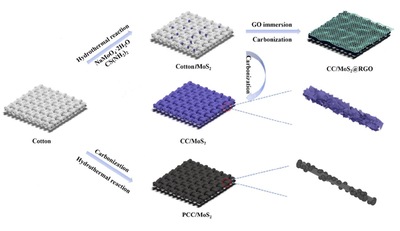Cotton textile inspires MoS2@reduced graphene oxide anodes towards high-rate capability or long- cycle stability sodium/lithium-ion batteries
Abstract: Textile-based energy storage devices are essential parts of wearable electronics and self-powered inte- grated systems. As electrode substrates, metal deposition or carbon coating on textile makes it conduc- tive. However, the process is complicated and would sacrifice the adhesion of active materials. Herein, we fabricated a cotton textile-derived carbon (CC)/MoS2@reduced graphene oxide (RGO) flexible binder-free electrode by growing MoS2 on the surface and interior of cotton, followed by dipping in GO solution and calcination. Protected by the formed MoS2 nanosheets, the structural integrity of Cotton/MoS2 can be guaranteed, while the hydrophilic cotton textile favors high mass loading of MoS2. High conductivity is realized on CC/MoS2@RGO by the pyrolysis of cotton and RGO encapsulation, which plays the vital role of accommodating the volume expansion/contraction during discharge/charge as well. As expected, the CC/MoS2@RGO textile electrode presents superior energy storage performances, including a rate capa- bility of 300.6 mA h g−1 at 2 A g−1 for sodium ion batteries and capacity of 141.7 mA h g−1 after 2000 cycles for lithium-ion batteries, which are elucidated by the morphology differences that sodiation/deso- diation brings an intense nanomachine effect on grinding the MoS2 nanosheets into nanoparticles. Meanwhile, full batteries are constructed and displays an initial capacity of 849.6 mA h g−1, indicating the potential applications.

Liu, Xue, et al. Cotton textile inspires MoS 2@ reduced graphene oxide anodes towards high-rate capability or long-cycle stability sodium/lithium-ion batteries. Inorganic Chemistry Frontiers. 2023. 10(1). 267-279.